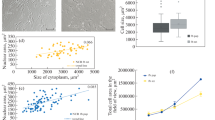Abstract
Fibroblasts grown from the skin of patients with Marfan's syndrome (mother and son) were investigated cytogenetically and biochemically together with fibroblasts from healthy individuals.
In Marfan's syndrome the cross-linking of the tropocollagen chains is disturbed already on the cellular level. The high ratio of soluble collagen to insoluble collagen (3:1), compared with controls, where the ratio is 1:1, supports this concept. The high free hydroxyproline content in normal fibroblasts and in those of Marfan's syndrome (in early passages) forming about 70% of total cell hydroxyproline speaks for the participation of fibroblasts not only in the synthesis but also in the catabolism of newly formed young forms of collagenous proteins. In contrast to controls the fibroblasts from the skin of both patients suffering from Marfan's syndrome changed in the sense of ageing depending on the duration of their cultivation in vitro. This stability is illustrated by the equalization of the ratio of soluble to insoluble collagenous proteins to 1:1.
Similar content being viewed by others
References
Fitch, S. M., M. L. R. Harkness, and R. D. Harkness: Extraction of collagen from tissue. Nature (Lond.) 176, 163 (1955).
Glynn, E. E.: Diseases of collagen and related tissue. In: Int. Rev. Conn. Tissue Res. Ed.: D. A. Hall. Vol. 2, p. 214–241. London-New York: Academic Press 1964.
Gross, J.: Mechanisms of connective tissue remodelling and resorption during anuran metamorphosis; in: The structure and function of connective and skeletal tissue. Ed.: S. F. Jackson, R. D. Harkness, S. M. Partridge, and G. M. Tristram, p. 426–430. London: Butterworth 1965.
Handmaker, S. D.: The satellited chromosomes of man with reference to the Marfan's syndrome. Amer. J. hum. Genet. 15, 11–17 (1963).
Hayflick, L., and P. S. Moorhead: The serial cultivation of human diploid cell strains. Exp. Cell. Res. 25, 585–621 (1961).
Hurych, J., and M. Chvapil: The role of free hydroxyproline in the biosynthesis of collagen. Biochim. biophys. Acta (Amst.) 107, 91–96 (1965).
Jones, Ch. R., M. W. Bergman, P. J. Kittner, and W. Pigman: Urinary hydroxyproline excretion in Marfan's syndrome as compared with age matched controls. Proc. Soc. exp. Biol. (N. Y.) 116, 931–933 (1964).
Lamy, M., M. L. Jammet et B. Dejoulx: La maladie de Marfan. Pédiatrie 19, 61–70 (1964).
Lenz, W.: Marfan's syndrome. Humangenetik. Ed.: P. E. Becker, part II., p. 102–106. Stuttgart: Thieme 1964.
Lindstead, S., and D. J. Prockop: Isotopic studies on urinary hydroxyproline as evidence for rapidly catabolized forms of collagen. J. biol. Chem. 236, 1399–1403 (1961).
Macek, M.: Simple micromethod for chromosomal analysis from capillary blood. Folia Biol. (Praha) 11, 299–304 (1965).
— and J. Michl: A contribution to the culturing of human diploid cells. Acta Univ. Carol. Med. (Praha) 10, 519–539 (1964).
McKusick, V. A.: Heredity and diseases of connective tissue. Ann. N. Y. Acad. Sci. 86, 1098–1108 (1960).
Meilman, E., and M. Urivetzky: Studies on urinary hydroxyproline. Arthr. and Rheum. 4, 119 (1961).
Michl, J.: Metabolism of cells in tissue culture in vitro. Exp. Cell Res. 23, 324–334 (1961).
Porter, K. R. and G. D. Papas: Collagen formation by fibroblasts of the chick embryo dermis. J. biophys. biochem. Cytol. 5, 153–166 (1959).
Prockop, D. J., and S. Udenfriend: A specific method for the analysis of hydroxyproline in tissue and urine. Analyt. Biochem. 1, 228–239 (1960).
Sjoerdsma, A., J. H. Davidson, S. Udenfriend, and C. Mitoma: Increased excretion of hydroxyproline in Marfan's syndrome. Lancet 1958/II, 994.
Stegemann, H.: Mikrobestimmung von Hydroxyprolin mit Chloramin T und p-Dimethylaminobenzaldehyd. Hoppe-Seylers Z. physiol. Chem. 311, 41–45 (1958)
Tjio, J. H., T. T. Puck, and A. Robinson: The human chromosomal satellites in normal persons and in two patients with Marfan's syndrome. Proc. nat. Acad. Sci. (Wash.) 46, 532–539 (1960).
Verzár, F.: Aging of collagen fiber. In: Int. Rev. Conn. Tissue Res. Ed.: D. S. Hall. Vol. 2, p. 244–300, London-New York: Academic Press 1964.
Wood, G. C.: The heterogeneity of collagen solutions and its effect on fibril formation. Biochem. J. 84, 429–435 (1962).
Yamakova, K., K. Kitamura, H. Ohta, and J. Noda: Experimental studies on medionecrosis of the aorta. — Discussion on the underlying factors of lathyrism, Ehlers-Danlos and Marfan's syndromes. Jap. Heart J. 1, 408–417 (1960).
Author information
Authors and Affiliations
Rights and permissions
About this article
Cite this article
Macek, M., Hurych, J., Chvapil, M. et al. Study on fibroblasts in Marfan's syndrome. Hum Genet 3, 87–97 (1966). https://doi.org/10.1007/BF00291289
Received:
Issue Date:
DOI: https://doi.org/10.1007/BF00291289




